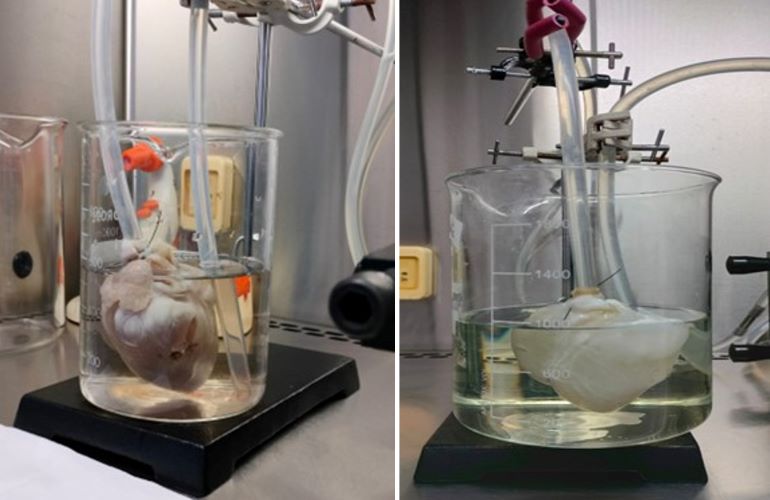The Gift of the Organ is Equivalent to the Gift of Life

Heart – Before (left) and After (right) Decellularisation
Dr Pradeep V Mahajan
In the realm of medical science, the act of organ donation is often equated with the divine gift of life itself. It’s a profound gesture of compassion, one that transcends boundaries and brings hope to countless individuals facing the direst of circumstances. However, despite tremendous advancements in medical technology, the challenges of organ rejection and the limited availability of organs have remained stubbornly unanswered for the past seven decades since the groundbreaking renal transplant of 1954 in Boston.
Yet, hope continues to spring eternal in the field of regenerative medicine. StemRx, a pioneering organisation at the forefront of biomedical innovation, is poised to revolutionize the landscape of organ transplantation. Through a multifaceted approach that encompasses cutting-edge technologies like 3D bioprinting, cell transplantation, and, most notably, decellularization, StemRx is taking a giant leap toward solving the organ shortage crisis.
Decellularisation, a remarkable process gaining prominence in the field, is now being harnessed by StemRx to manufacture organs within the confines of a laboratory. In this quest to gift life, researchers worldwide are leaving no stone unturned, aiming to develop organs that could one day serve as readily available replacements for those in need.
One such promising endeavor involves the decellularisation of porcine hearts. This approach could potentially offer a blueprint for the future creation of human organs. The process is intricate yet fascinating, involving the complete removal of cellular components from the porcine heart while preserving the vital extracellular matrix (ECM) structure. This decellularised ECM serves as a three-dimensional template that could be recellularised with either human cardiomyocytes or endothelial cells, rendering it suitable for organ transplantation, disease modeling, and drug discovery.
The Decellularisation Process
The heart of this revolutionary endeavor lies in the method of decellularisation. Porcine hearts are chosen for their similarity to the human heart, making them excellent candidates for study and experimentation. The process begins with perfusion, a technique that involves circulating a specialized solution containing detergents, enzymes, and other agents through the heart’s vasculature.
Picture this: a porcine heart, once vibrant with life, now suspended in a sterile laboratory environment. Tubes and catheters intricately connected to the heart’s arteries and veins ensure the efficient distribution of the decellularization solution. This solution effectively washes away the cellular components of the heart, leaving behind an intricate scaffolding – the ECM structure.
What remains is a ghostly, translucent framework of the original heart, devoid of cells but retaining the intricate architecture that allows the heart to function. This decellularized heart serves as a remarkable 3D template, ready to be populated with the life-giving cells required for it to beat once more.
The Promise of Decellularisation
The potential of decellularisation is nothing short of extraordinary. These decellularised organs can be reseeded with either porcine myocardial cells or endothelial cells, creating pulsating hearts in the controlled environment of a laboratory. These hearts, while not suitable for immediate transplantation into humans, serve as invaluable tools for research, testing, and development.
Decellularised organs open up new avenues for understanding heart biology, drug testing, and even personalised medicine. They can be used to study disease progression, screen potential medications, and investigate novel treatment approaches. Furthermore, they provide a stepping stone toward the ultimate goal: bioengineered human organs that can address the perpetual shortage of transplantable hearts and save countless lives.
In conclusion, the science of gifting organs is indeed the science of gifting life itself, akin to a divine act of benevolence. StemRx’s pioneering work in the field of decellularisation, as exemplified by their work with porcine hearts, holds the promise of reshaping the future of organ transplantation. Through meticulous research and innovative technologies, we inch closer to a world where the gift of an organ can truly be equated with the gift of God – a gift that offers hope, healing, and the opportunity for a new lease on life.
Dr Pradeep V. Mahajan, MBBS, MS (General Surgery), DU (Urology, Austria), AFIH (Associate Fellow of Industrial Health, (Government of India), is Diplomat – American Board of Regenerative Medicine (ABRM)

